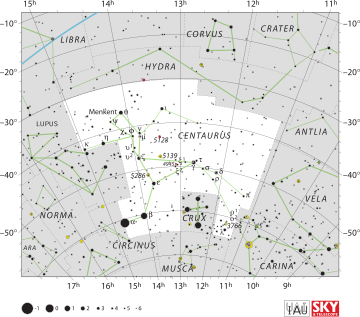센타우루스자리 감마
Gamma Centauri| 관찰 데이터 Epoch J2000 Equinox J2000 | |
|---|---|
| 콘스텔레이션 | 켄타우루스 |
| 적경 | 12h 41m 31.04008s[1] |
| 적위 | -48°57°35.5375°[1] |
| 겉보기 등급(V) | +2.17[2] (+2.85/+2.95)[3] |
| 특성. | |
| 스펙트럼형 | A1IV+([4]A1IV+A0IV)[5] |
| U-B 색지수 | −0.01[2] |
| B-V 색지수 | −0.01[2] |
| 아스트로메트리 | |
| 반지름 속도(Rv) | - 5.5 km[6]/s |
| 고유운동(μ) | RA: - 802.72[1] mas/년 Dec.: +5.79[1] mas/년 |
| 시차()) | 25.06 ± 0.28 mas[1] |
| 거리 | 130 ± 1y (39.9 ± 0.4 pc) |
| 절대 등급(MV) | −0.81[7] |
| 궤도[8] | |
| 동반자 | § 센타우루스자리 B |
| 기간(P) | 83.57±0.21 yr |
| 반장축(a) | 0.869±0.011 °C |
| 편심(e) | 0.793±0.003 |
| 기울기(i) | 113.7±0.7° |
| 노드의 경도(δ) | 2.6±0.7° |
| 근일점 에폭(T) | 1,931.25 ± 0.07 |
| 근일점 인수()) (세컨더리) | 187.9±1.5° |
| 세부 사항 | |
| 덩어리 | 2.91[9] M☉ |
| 표면 중력(log g) | 3.52gs[4] |
| 온도 | 9,082[4] K |
| 기타 명칭 | |
| 데이터베이스 참조 | |
| 심바디 | 데이터. |
센타우루스자리 감마( latin Centururi)는 남쪽 켄타우루스자리에 있는 쌍성계이다.그것은 Muhlifain이라는 [10]고유 이름을 가지고 있는데, Muhlifein이라는 Muliphein과 혼동하지 않고, 두 이름은 같은 아랍어 어근에서 유래했다.이 계는 겉보기 등급 +2.17의 단일 광점으로 [2]육안으로 볼 수 있으며, 각각은 3등급 [3]별이다.
이 시스템은 시차를 기준으로 태양으로부터 약 130광년(40파섹) 거리에 있습니다.2000년에, 이 쌍은 위치 각도가 351.[3]9°이고 1.217초의 각도 간격을 가지고 있었다.이들의 위치는 1897년부터 관측되어 왔으며, 이는 공전 주기가 84.5년이고 반시계 축이 [11][8]0.93초인 것으로 추정할 수 있을 만큼 길다.이 시스템의 거리에서는 약 [12]93AU의 물리적 거리에 해당합니다.
이 쌍성의 합친 항성 분류는 A1이다.IV+.[4] 분리 시 A1의 개별 클래스가 있습니다.IV와 A0IV는 [5]거성이 되는 과정에서 A형 준거성이라는 것을 암시합니다.센타우루스자리 타우는 감마 센타우리에서 비교적 가까우며, 거리는 1.72광년(0.53파섹)[9]으로 추정된다.이들이 함께 움직이는 [8]별일 확률은 98%입니다.
어원학
중국 천문학에서 庫(K ló Lou)는 아스널을 의미하며 centauri 센타우루스, centauri 센타우루스, centauri 센타우루스, centauri 센타우루스, centauri 센타우루스, 2 센타우루스, HD 117440, centauri1 센타우루스, centauri 센타우루스,[13] centauri 센타우루스 등으로 구성된 별자리를 말한다.따라서 센타우리의 중국 이름은 樓uk(K ló Lou qī, 영어:[14] 아스널의 일곱 번째 별)이다.
호주 중부 허먼스버그 주변의 아란다와 루리차 부족 사람들은 이 별을 구성하는 사각형 배열인 δ Cen (마웨이), cru Cru (이마이), cru Cru (가크룩스)를 이리징가 (독수리매)[15]라고 명명했다.
레퍼런스
- ^ a b c d e van Leeuwen, F. (November 2007). "Validation of the new Hipparcos reduction". Astronomy and Astrophysics. 474 (2): 653–664. arXiv:0708.1752. Bibcode:2007A&A...474..653V. doi:10.1051/0004-6361:20078357. S2CID 18759600.
- ^ a b c d Johnson, H. L.; et al. (1966). "UBVRIJKL photometry of the bright stars". Communications of the Lunar and Planetary Laboratory. 4 (99): 99. Bibcode:1966CoLPL...4...99J.
- ^ a b c Fabricius, C.; Makarov, V. V. (April 2000). "Two-colour photometry for 9473 components of close Hipparcos double and multiple stars". Astronomy and Astrophysics. 356: 141–145. Bibcode:2000A&A...356..141F.
- ^ a b c d Gray, R. O.; et al. (July 2006). "Contributions to the Nearby Stars (NStars) Project: Spectroscopy of Stars Earlier than M0 within 40 pc-The Southern Sample". The Astronomical Journal. 132 (1): 161–170. arXiv:astro-ph/0603770. Bibcode:2006AJ....132..161G. doi:10.1086/504637. S2CID 119476992.
- ^ a b Gray, R. O.; Garrison, R. F. (December 1987). "The Early A-Type Stars: Refined MK Classification, Confrontation with Stroemgren Photometry, and the Effects of Rotation". Astrophysical Journal Supplement. 65: 581. Bibcode:1987ApJS...65..581G. doi:10.1086/191237.
- ^ Evans, D. S. (June 20–24, 1966). Batten, Alan Henry; Heard, John Frederick (eds.). The Revision of the General Catalogue of Radial Velocities. Determination of Radial Velocities and their Applications, Proceedings from IAU Symposium no. 30. University of Toronto: International Astronomical Union. Bibcode:1967IAUS...30...57E.
- ^ Schaaf, Fred (2008). The brightest stars: discovering the universe through the sky's most brilliant stars. The Brightest Stars: Discovering the Universe Through the Sky's Most Brilliant Stars. John Wiley and Sons. p. 262. Bibcode:2008bsdu.book.....S. ISBN 978-0-471-70410-2.
- ^ a b c Argyle, R. W.; et al. (May 2015). "Micrometric measures and orbits of southern visual double stars". Astronomische Nachrichten. 336 (4): 378–387. Bibcode:2015AN....336..378A. doi:10.1002/asna.201412166.
- ^ a b Shaya, Ed J.; Olling, Rob P. (January 2011). "Very Wide Binaries and Other Comoving Stellar Companions: A Bayesian Analysis of the Hipparcos Catalogue". The Astrophysical Journal Supplement. 192 (1): 2. arXiv:1007.0425. Bibcode:2011ApJS..192....2S. doi:10.1088/0067-0049/192/1/2. S2CID 119226823.
- ^ Paul Kunitzsch (1959). Arabische Sternnamen in Europa, von Paul Kunitzsch. O. Harrassowitz. p. 188.
- ^ Mason, Brian D.; et al. (December 2001). "The 2001 US Naval Observatory Double Star CD-ROM. I. The Washington Double Star Catalog". The Astronomical Journal. 122 (6): 3466–3471. Bibcode:2001AJ....122.3466M. doi:10.1086/323920.
- ^ Kaler, James B. "MUHLIFAIN (Gamma Centauri)". Stars. University of Illinois. Retrieved 2011-12-31.
- ^ (in Chinese) 中國星座神話, written by 陳久金.2005년 발행, ISBN 978-986-7332-25-7.
- ^ 2011년 1월 30일 홍콩우주박물관 웨이백머신에서 보관.2010년 11월 23일에 온라인으로 액세스.
- ^ Raymond Haynes; Roslynn D. Haynes; David Malin; Richard McGee (1996), Explorers of the Southern Sky: A History of Australian Astronomy, Cambridge: Cambridge University Press, p. 8, ISBN 978-0-521-36575-8
